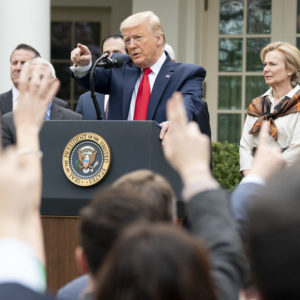Editor’s Note: For another viewpoint, see Fake News Is Hard to Eliminate Because People Want It
One of President Trump’s common refrains during the 2016 election that continues to this day is “fake news.”
His labeling of collective media outlets and those they employ has presented journalists with a choice: to stick to decades-old White House press briefing decorum or play by a new set of rules.
Clicks are the top priority in an oversaturated media landscape and viral sound bites chiding the president are rewarded with earned media, so we’ve watched many journalists respond to this reality. They decry the president’s form while simultaneously playing his game to reap professional benefits and accolades.
Enter the new normal at the White House press briefing.
President Trump gives an opening statement, which includes information on the latest issue, praise for those working on that issue and self-adulation for the work he’s done. Then he turns it over to the press, where ratings and retweets abound — it’s good TV.
While no-nonsense questions come from the first few raised hands, the president eventually calls on journalists who want a piece of his spotlight. Instead of data-driven questions that require information-filled answers, there’s often a shift in focus to make the question about the person asking it. These types of “questions” fall into three categories:
The Statement — At the beginning of the global pandemic, CNN’s Jim Acosta “asked” the president: “Some of the officials paint a rosy picture of what is happening around the country. If you look at some of these questions — do we have enough masks? No. Do we have enough tests? No. Do we have enough PPE (personal protective equipment)? No.” Acosta answered his own questions. He used his time to grandstand and make it clear that he disagreed with what the president had said.
Fake News Debate — When the president deems a statement, question or accusation as unfair, he calls it out. This usually leads to a debate about who lies more. For example, Acosta is on the record in this type of setting with the following statement: “Mr. President, I think our record on delivering the truth is a lot better than yours sometimes, if you don’t mind me saying.”
Grandstanding — The fake news debate can escalate further, but only a few are willing to engage and blatantly talk over the president. The most egregious example of Acosta exhibiting this behavior led to his press pass being revoked temporarily.
He verbally sparred with the president and then refused to give the microphone back to the intern. This led to more speaking over the president, who then walked away from the podium out of clear frustration.
Now you may be thinking: But Trump eggs them on! True, Trump is stylistically unlike most other American presidents; however, his style is authentic to who he is. He was a known commodity for firing people on “The Apprentice” before the White House, and he has stayed true to his brand. His base loves him for it; his enemies hate him for it.
The problem for many journalists and politicians who’ve chosen to get in the ring and “fight” with Trump is they try to mimic his style and fail miserably because they’re being inauthentic.
While some love to see journalists dump on the president, these journalists quickly lose their credibility to the general public. And they enable Trump to further his narrative of “fake news.”
What journalists should do is stick to good old-fashioned journalism.
Not only is it best to let the details do the talking so the American people can come to their own conclusions, but doing so would also force Trump to change his style or risk being ridiculed.
His style needs a counter, without which his accusations against the press wouldn’t stand. He would look unjustified in his handling of journalists and their questions if they remained above reproach and didn’t take the bait.
But we’ve watched this fight play out for the past three years, and sadly, it’s not going away. It benefits both the president and the press as they control a news cycle that centers on polarization.
And as an audience it’s hard to look away because love it or hate it, it’s quite the show.

